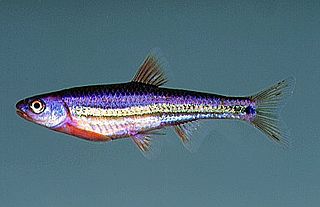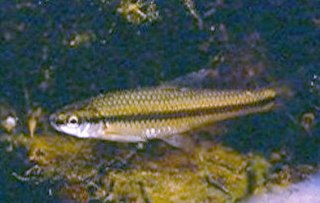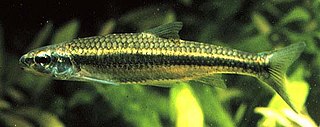
Cypriniformes is an order of ray-finned fish, which includes many families and genera of cyprinid fish, such as barbs, gobies, loaches, botias, and minnows. Cypriniformes is an “order-within-an-order”, placed under the superorder Ostariophysi—which is also made up of cyprinid, ostariophysin fishes. The order contains 11-12 families, over 400 genera, and more than 4,250 named species; new species are regularly described, and new genera are recognized frequently. Cyprinids are most diverse in South and Southeast Asia, but are entirely absent from Australia and South America. At 112 years old, the longest-lived cypriniform fish documented is the bigmouth buffalo.

Minnow is the common name for a number of species of small freshwater fish, belonging to several genera of the families Cyprinidae and Leuciscidae. They are also known in Ireland as pinkeens.

Homalopsis buccata is a species of mildly venomous snake in the Homalopsidae family found in tropical areas of Southeast Asia.

Notropis is a genus of freshwater fish in the family Cyprinidae. They are known commonly as eastern shiners. They are native to North America, and are the continent's second largest genus.
Notropis aguirrepequenoi is a species of fish in the family Cyprinidae, the carps and minnows. Its common name is the Soto la Marina shiner. It is endemic to Mexico, where it occurs in the lower Rio Grande.

The smalleye shiner is a species of ray-finned fish in the family Cyprinidae. It is found only in the upper Brazos River basin of Texas, which includes the Double Mountain and Salt forks of the upper Brazos. It became a candidate for federal listing as an endangered species of the United States in 2013.

The Cape Fear shiner is a North American species of freshwater fish in the family Cyprinidae. It is endemic to the central part of the state of North Carolina in the southeastern United States, and is only found in the shallow streams of the Cape Fear River basin. The fish is small and yellow with black lips and a black stripe that runs down the middle of the fish's side. This shiner is normally found in mixed schools with other minnow species. It is unique amongst its genus because it has elongated intestines that are specifically adapted to a primarily herbivorous diet. It can breed twice a year and normally lives for only two or three years in the wild. The males and females are normally similar in appearance but become different colors in the spawning season. This species of shiner was not discovered until 1962.

The sand shiner is a widespread North American species of freshwater fish in the family Cyprinidae. Sand shiners live in open clear water streams with sandy bottoms where they feed in schools on aquatic and terrestrial insects, bottom ooze and diatoms.
The whitemouth shiner is a species of fish in the family Cyprinidae, the carps and minnows. It is native to the eastern United States, where it occurs in the Piedmont in the states of Virginia, North Carolina, and South Carolina.
The longjaw minnow is a species of cyprinid fish that is endemic to the United States.

The pugnose shiner is a species of ray-finned fish in the genus Notropis. It is in the family Cyprinidae which consists of freshwater carps and minnows. Cyprinidae is the largest fish family which consists of about 369 genera and 3,018 species. Its distribution has been decreasing due to the removal of aquatic plants in order to create swimming beaches and boating access in freshwater lakes and is now mostly found in Minnesota, Wisconsin, and Michigan.

Redeye chub is a species of cyprinid fish native to freshwaters of southeastern North America.

The spottail shiner or spottail minnow is a small- to medium-sized freshwater minnow. It can be found as far north as Canada and as far south as the Chattahoochee River in Georgia. These shiners live in lakes, rivers, and creeks. They occupy the rocky or sandy shorelines and bottoms of the water. One of the defining features of a spottail shiner is the black spot found at the base of the caudal fin. These shiners generally spawn from late June through July.

The Ozark minnow is a species of ray-finned fish in the genus Notropis.

Silverjaw minnows are part of the family Cyprinidae, which includes carps and minnows. With over 300 known species, there are more species of minnows native to North America's fresh waters than any other fish. Minnows can be hard to distinguish because many look alike. All minnows have one dorsal fin, ventral fins near the anus, a lateral line system, and smooth, round cycloid scales. Their jaws lack teeth, but they have one to three rows of pharyngeal teeth to grind food. Defining physical characteristics such as the number and type of fin rays, type of scales, and pattern of pharyngeal teeth are used to distinguish minnows.

Leuciscinae is a subfamily of the freshwater fish family Cyprinidae, which contains the true minnows.

Mayaheros is a genus of cichlid fish that is native to Mexico and northern Central America. This genus has a disjunct distribution, with the M. urophthalmus group being found in the Atlantic drainages of southeastern Mexico, Belize, eastern Guatemala, northern Honduras and northeastern Nicaragua, while M. beani is the northernmost cichlid in the Pacific drainage, ranging from Jalisco to Sonora in northwestern Mexico. Both inhabit a wide range of habitats such as freshwater rivers, streams, lakes, ponds, pools and marshes, as well as brackish waters like estuaries, lagoons and mangrove, with members of the M. urophthalmus group sometimes even occurring in caves or coastal marine waters. They are medium-sized to large cichlids that are omnivorous, feeding mostly on small animals, but also plants and detritus.

The bleeding shiner is a freshwater ray-finned minnow in the family Leuciscidae, which was recently changed to distinguish between North American and Asian minnows. It occurs in tributaries of Ozark-draining tributaries of the Missouri, and Mississippi rivers in southern Missouri and northeastern Arkansas. Its preferred habitat is rocky and sandy pools and runs of headwaters, creeks and small rivers.














